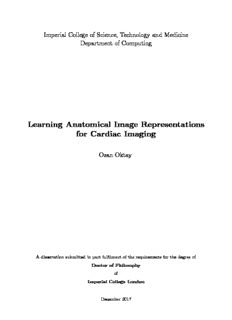
Learning Anatomical Image Representations for Cardiac Imaging PDF
Preview Learning Anatomical Image Representations for Cardiac Imaging
Imperial College of Science, Technology and Medicine Department of Computing Learning Anatomical Image Representations for Cardiac Imaging Ozan Oktay A dissertation submitted in part fulfilment of the requirements for the degree of Doctor of Philosophy of Imperial College London December 2017 Abstract Advances in cardiac imaging techniques play a vital role in fighting against cardiovascular diseases by helping achieve early and accurate diagnoses as well as guidance in interventional cardiac procedures. Along with these imaging systems, computer-aided diagnosis (CAD) is essential in modern healthcare to yield useful and comprehensive clinical information in a short time. However, CAD systems have not been widely adopted in clinical practice due to technical limitations imposed by the imaging systems. In particular, cardiac cine Magnetic Resonance (MR) imaging has a low through-plane resolution and may contain motion artefacts due to the acquisition process. Similarly, the quality of cardiac ultrasound images is operator- dependent and often has poor signal-to-noise-ratio, which presents difficulties for automated image analysis. To tackle these limitations and enhance the accuracy and robustness of the automated image analysis, this thesis focuses on the development and application of state-of-the-art machine learning (ML) techniques in cardiac multi-modal imaging. Specifically, we propose new image feature representation types that are learnt with ML models and aimed at highlighting the correspondences between multi-modal data. These representations are also intended to visu- alise the cardiac anatomy in more detail for better interpretation and analysis. Moreover, we investigate how quantitative analysis can benefit when these learnt image representations are used in segmentation, motion-tracking and multi-modal image registration. Specifically, a probabilistic edge-map representation is introduced to identify anatomical corre- spondences in multi-modal cardiac images and demonstrate its use in spatial image alignment and anatomical landmark localisation problems. Additionally, a novel image super-resolution framework is introduced for the enhancement of cardiac cine MR images and we show that high resolution image representation can be useful and informative for various types of subsequent analysis including volumetric measurements and strain analysis. i ii Acknowledgements First and foremost I wish to thank my supervisor Prof. Daniel Rueckert, for giving me the opportunity to pursue a PhD degree and work alongside him. He has been a constant source of support and inspiration for me, and it has been a great pleasure and privilege to carry out my PhD research under his supervision. I still do remember my first PhD meeting with him, when he suggested me to do lots of reading and particularly machine learning, which has probably influenced my research career the most. Dozens of people have helped and taught me immensely at the BioMedIA group over the last four years. I am very thankful to everyone, especially to Jose, Jonathan, Kevin, Gregor, Salim, Martin, and Giacomo for all the good and fun memories. Special thanks to Wenjia and Wenzhe for their help and guidance, without whom we would not have been able to complete the research work presented in this thesis. I also need to thank to Dr. Declan O’Regan, Dr. Antonio de Marvao, and Dr. Timothy Dawes of the Robert Steiner MR imaging unit at Hammersmith Hospital for their clinical feedback and for providing almost all the MR imaging data presented in this thesis. I also would like to express my special thanks to Agnes for her loving support and endless patience during my studies. Finally, I am deeply grateful to my parents and brother for their constantsupportandlove, whohavegivenmeallthestrengthandcouragetofollowmydreams. iii To my ever dearest mother ... Declaration of originality I declare that the work presented in this thesis is my own, unless specifically acknowledged. Ozan Oktay. v Copyright Declaration The copyright of this thesis rests with the author and is made available under a Creative Commons Attribution Non-Commercial No Derivatives licence. Researchers are free to copy, distribute or transmit the thesis on the condition that they attribute it, that they do not use it for commercial purposes and that they do not alter, transform or build upon it. For any reuse or redistribution, researchers must make clear to others the licence terms of this work. vi Acronyms ACNN Anatomically Constrained Neural Network. AE Autoencoder. AL Adversarial Learning. AW Anterior Wall. CAD Computer-Aided Diagnosis. CMR Magnetic Resonance Imaging. CNN Convolutional Neural Network. CT Computed Tomography. CVD Cardiovascular Disease. DBN Deep Belief Network. DF Decision Forest. ED End-Diastolic. EF Ejection Fraction. EM Expectation Maximisation. ES End-Systolic. vii FFD Free-Form Deformations. GM Gradient Magnitude. HR High Resolution. LAX Long Axis. LR Low Resolution. LV Left Ventricle. MI Mutual Information. ML Machine Learning. MR Magnetic Resonance. MRF Markov Random Field. MRI Magnetic Resonance Imaging. PEM Probabilistic Edge Map. PEM-MA Probabilistic Edge Map based Multi-Atlas Segmentation. PSNR Peak Signal-to-Noise Ratio. SAX Short Axis. SDF Structured Decision Forest. SR Super Resolution. SR-CNN Super-Resolution Convolutional Neural Network. SSD Sum of Squared Differences. viii
Description: